This article was published in Scientific American’s former blog network and reflects the views of the author, not necessarily those of Scientific American

Sure, I was familiar with the graphic–and I’m not alone. Drop this image (right) on someone’s desk and chances are they’ll reflexively blurt, “Joy Division.” The band’s 1979 Unknown Pleasures album cover leaned entirely on a small mysterious data display, printed in white on black. No band name, album title or other identifiers. An interesting move for a debut studio album.
The cover image became an icon but remained mysterious. Even as knowledge spread about the band’s inspiration point–a preexisting pulsar data visualization (more on this below)–the true origin of that visualization continued to be a bit of a riddle. Somewhere along the way, I became obsessed with the narratives behind pulsar discovery and stacked plots, along with a growing desire to learn all that I could about the image and the research it was connected to. What follows is an abridged story borne of that obsession, starting with a video screened at a data visualization conference and ending with an interview with Harold (Hal) Craft, the radio astronomer who created the plot from data collected at the Arecibo Radio Observatory.
On supporting science journalism
If you're enjoying this article, consider supporting our award-winning journalism by subscribing. By purchasing a subscription you are helping to ensure the future of impactful stories about the discoveries and ideas shaping our world today.
* * *
In late 2012 I saw the Unknown Pleasures album cover in a new light. VISUALIZED conference attendees were treated to a screening of Data Visualization, Reinterpreted: The Story of Joy Division’s Unknown Pleasures Album (directed by Eric Klotz and Volkert Besseling). Check out the video below for an interview with the album cover designer, Peter Saville.
As Saville explains, the cover is directly linked to a figure in The Cambridge Encyclopaedia of Astronomy (1977 edition)–a stacked plot of radio signals from a pulsar. My interest was piqued. I’m far from a music and album art expert but visualizing astronomical phenomena is part of my job description. Although I jotted down notes, my intention to look further into things faded.
Then, nearly two years later, when chatting with artist Philippe Decrauzat about his influences, my jaw hit the floor. His collection of favorite 1960s and 1970s Scientific American graphics included the stacked plot. It had been printed as a full-page figure in the January 1971 issue; white radio pulses on a field of cyan. My interest was piqued anew, to say the least.
When folks refer to the Unknown Pleasures cover, they generally just say that it shows a series of radio frequency periods from the first pulsar discovered. But what does that really mean? How does the physicality of a pulsar result in radio frequencies that translate into the famous stacked plot? What produced the data, how was it collected, who created the plot and what is its significance?
First, a short pulsar primer (keep an eye on this blog in the coming months for a more in-depth discussion on the history of pulsar visualization and explanatory graphics). From Jacob Shaham’s February 1987 Scientific American article “The Oldest Pulsars in the Universe:“
“[Radio pulsars] are thought to be rotating neutron stars: huge, spinning ‘nuclei’ that contain some 1057 protons and neutrons…. The large clump of nuclear matter, which has a mass about equal to that of the sun, is compressed into a sphere with a radius on the order of 10 kilometers. Consequently, the density of the star is enormous, slightly greater than the density of ordinary nuclear matter, which is itself some 10 trillion times denser than a lead brick. Currents of protons and electrons moving within the star generate a magnetic field. As the star rotates, a radio beacon, ignited by the combined effect of the magnetic field and the rotation, emanates from it and sweeps periodically through the surrounding space, rather like a lighthouse beam. Once per revolution the beacon cuts past the earth, giving rise to the beeping detected by radio telescopes.”
Although the image on the cover is largely cited correctly as depicting the first pulsar discovered (CP 1919), it’s not the first isolated plot of that pulsar, which was made in 1967. That honor goes to Jocelyn Bell Burnell from the Mullard Radio Astronomy Observatory in Cambridge, England, as published in Nature on February 24, 1968. (Scientific American is part of Nature Publishing Group.)
I quickly learned that I’m not the first to jump down the rabbit hole in search of the creator of the stacked plot. Adam Capriola has documented his search with regular updates, and notes three key pre-album occurrences of the figure. I checked out those three artifacts to see if they would lead to more information about the creator of the plot and/or its significance. In reverse order of printing:
1. The Cambridge Encyclopaedia of Astronomy, edited by Simon Mitton. Prentice-Hall of Canada, by Terwin Copplestone Publishing, 1977. No source credit for the plot can be found in the text, other than a general book-wide “diagrams and graphs by Michael Robinson” nod. There’s a great four-page summary about pulsars and several diagrams but not much detail about the stacked plot itself, beyond the figure caption.
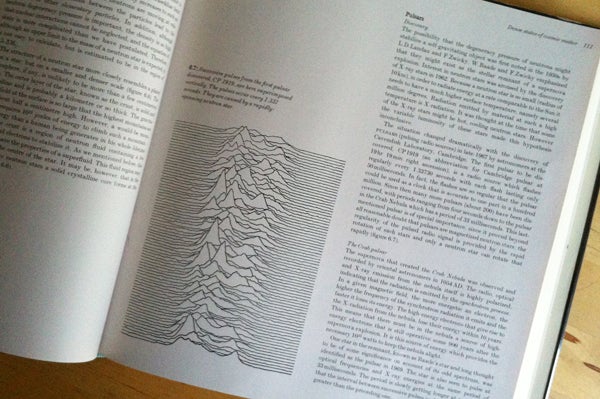
“Successive pulses from the first pulsar discovered, CP 1919, are here superimposed vertically. The pulses occur every 1.337 seconds. They are caused by rapidly spinning neutron star.” From The Cambridge Encyclopaedia of Astronomy.
2. Graphis Diagrams: The Graphic Visualization of Abstract Data, edited by Walter Herdeg, The Graphis Press, Zurich, 1974. Included in a catalogue of data visualizations on scientific topics, attributed on the credits page to the Arecibo Radio Observatory.
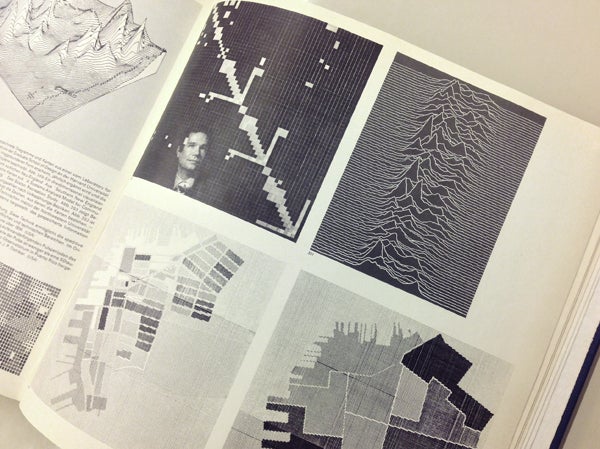
“Von einem Computer erzeugte illustration von achtzig aufeinanderfolgenden Pulsperioden des ersten Pulsars, der beobachtet wurde. Die Durchschnittsbreite der Pulse ist weniger als eine 50tausendstel-Sekunde. Das Diagramm wurde vom Arecibo Radio-Observatorium in Puerto Rico hergestellt. Aus Scientific American, 'The Nature of Pulsars,' von J. P. Ostriker (U.S.A.).” From Graphis Diagrams: The Graphic Visualization of Abstract Data
3. “The Nature of Pulsars” by Jeremiah P. Ostriker, Scientific American, January 1971 (pages 48-60); Credited to Arecibo Radio Observatory in the issue’s illustration credit box on page 4. I’m clearly biased, but this article provides a neat and accessible view into the early days of pulsar data collection and theory (particularly when paired with “Pulsars,” by Antony Hewish, Scientific American, October 1968). It highlights the significance of the plot in the caption and hints to the nature of the research it was connected to (pulse shape and irregularity) but, sadly, doesn’t directly name the plot creator as part of the Arecibo credit line.
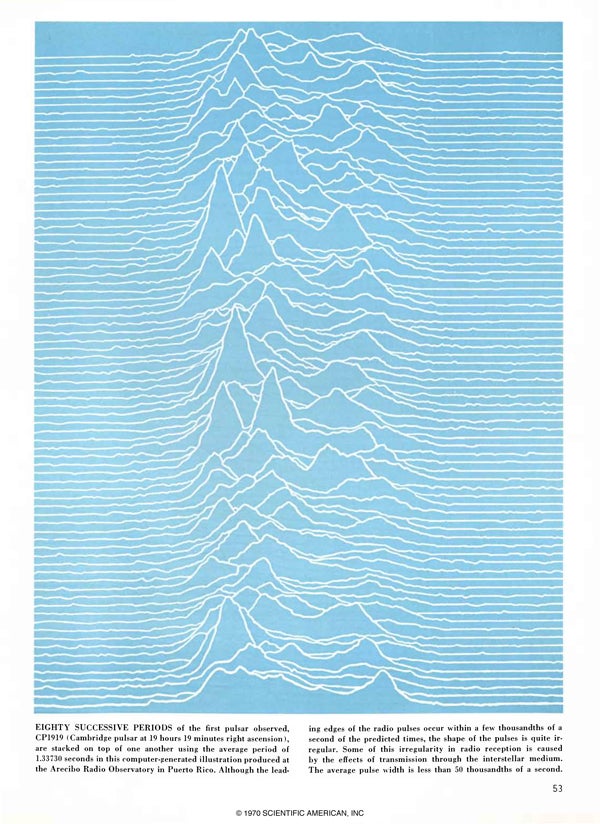
“EIGHTY SUCCESSIVE PERIODS of the first pulsar observed, CP1919 (Cambridge pulsar at 19 hours 19 minutes right ascension), are stacked on top of one another using the average period of 1.33730 seconds in this computer-generated illustration produced at the Arecibo Radio Observatory in Puerto Rico. Although the leading edges of the radio pulses occur within a few thousandths of a second of the predicted times, the shape of the pulses is quite irregular. Some of this irregularity in radio reception is caused by the effects of transmission through the interstellar medium. The average pulse width is less than 50 thousandths of a second.” From “The Nature of Pulsars,” by Jeremiah P. Ostriker, Scientific American, January 1971.
By now I had also combed through early discovery articles in scientific journals and every book anthology on pulsars I could get my hands on to learn more about early pulsar visualizations. The more I learned, the more this descriptor in the 1971 Ostriker caption began to feel significant; “computer-generated illustration.” The charts from Bell at Mullard were output in real time, using analogue plotting tools. A transition in technology from analogue to digital seemed to have been taking place between the discovery of pulsars in 1967 to the work being conducting at Arecibo in 1968 through the early 1970′s. A cohort of doctoral students from Cornell University seemed to be embracing that shift, working on the cutting edge of digital analysis and pulsar data output. One PhD thesis title from that group in particular caught my attention, “Radio Observations of the Pulse Profiles and Dispersion Measures of Twelve Pulsars,” by Harold D. Craft, Jr. (September 1970).
A trip to Cornell’s rare book room confirmed a hunch. Sure enough, there was the image in Craft’s thesis, along with two other stacked plots.
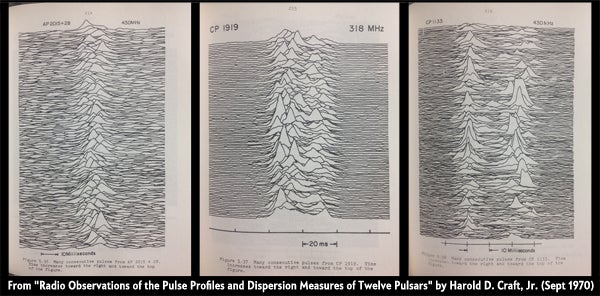
From “Radio Observations of the Pulse Profiles and Dispersion Measures of Twelve Pulsars,” by Harold D. Craft, Jr. (September 1970).
On February 16, 2015, I sat down with Craft just outside of Ithaca, N.Y., and asked him about his recollections of Arecibo, the data visualizations in his thesis and the Unknown Pleasures album cover.
Craft on pulsar research at the Arecibo Radio Observatory in the late 1960s:
Well, there were a number of graduate students who were down there at the time. Most of them were graduate students of Frank Drake. I was one of those, John Comella was another, Dave Richards was a third, I think Gus Zeissig might have been a fourth. As I recall, we were all together in one big room in the administrative building at Arecibo. And we were all actually pursuing a PhD thesis, experimental thesis in different stuff. And I, at the time, was doing radiometric temperature measurements of the surface of Venus, which didn’t seem to be going anywhere in particular. I was working also on a new design for the line feeds for Arecibo, and that also didn’t seem to be going anywhere. And then pulsars were discovered – not at Arecibo, obviously – by Jocelyn Bell at Cambridge. Arecibo, it turned out, was the perfect instrument to measure these things, because it had enormous sensitivity – easily the most sensitive instrument in the world at that time. It also had the rudiments of digital technology there, because it was a radar observatory, and the radar folks were using digital technology. Radio astronomy folks, including myself at the time, were primarily using – would you believe it – chart recorders, or very slow analogue to digital converters. So anyway, the instrumentation was all set up to make measurements on these things, and so a number of us turned immediately, saying, “hey, you know, this looks like an interesting thing to do.” Besides, Frank Drake encouraged us to focus on these, obviously a major scientific issue at the time, which we did. So all four of us focused on these, in different ways. And we just took off from there. It was an exciting time then. We were young graduate students, we didn’t know squat. But, here’s something new in astronomy that hadn’t been seen before, and we were at the best instrument in the world to look at them, and what better opportunity was there than that? So we just hopped on it.
Craft on stacked pulsar plots, leading up to the CP 1919 data visualization:
This plotting of sequences like this, it started just a little bit earlier when we were looking at potentially drifting subpulses within the major pulse itself. So, the thought was, well, is there something like this peak here, which on the next pulse moves over here, and then moves over here, and over there. Actually, would be moving this way in that case – either way. I think Frank Drake and I published a paper in Science Magazine on exactly that issue – suggesting there might be drifting subpulses within the major pulse, which would then get back to the physics of what was causing the emission in the first place. So, then the thought was, well let’s plot out a whole array of pulses, and see if we can see particular patterns in there. So that’s why, this one was the first I did – CP1919 – and you can pick out patterns in there if you really work at it. But I think the answer is, there weren’t any that were real obvious anyway. I don’t really recall, but my bet is that the first one of these that I did, I didn’t bother to block out the stuff, and I found that it was just too confusing. So then, I wrote the program so that I would block out when a hill here was high enough, then the stuff behind it would stay hidden. And it was pretty easy to do from a computer perspective. I also wrote a program that, instead of having these lined up vertically like this, I tilted them off at a slight angle like that so that it would look like you were looking up a hillside – which was aesthetically interesting and pleasing, but on the other hand, it just confused the whole issue.
Craft on preparing the original computer plots for thesis publication:
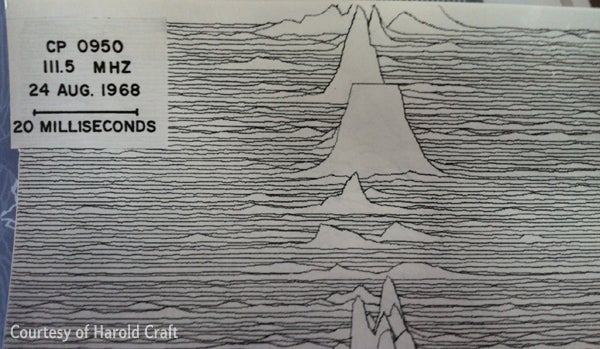
Detail of original Calcomp plotter output. Courtesy of Harold Craft.
So what happened, just in the process of putting together the thesis, I would give this [see image below] to a woman draftsperson in the space sciences building at Cornell, and she would then trace this stuff with india ink, and make a much darker image of it, so that it could be printed basically.
Craft on the Unknown Pleasures album cover:
It was a complete surprise. In fact, I didn’t know anything about it, and a colleague in the space sciences department, who is now a professor of astronomy at Cornell, Jim Cordes, saw me on the street – he’s been a long time friend – and he said, “oh, by the way, did you know that your image is on the cover of Joy Division?” And, I said no, I had no clue. So I went to the record store and, son of a gun, there it was. So I bought an album, and then there was a poster that I had of it, so I bought one of those too, just for no particular reason, except that it’s my image, and I ought to have a copy of it.